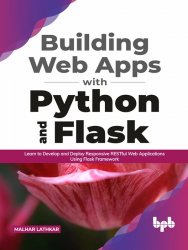Building Web Apps with Python and Flask: Learn to Develop and Deploy Responsive RESTful Web Applications Using Flask Framework
- Добавил: literator
- Дата: 11-09-2021, 18:44
- Комментариев: 0
 Название: Building Web Apps with Python and Flask: Learn to Develop and Deploy Responsive RESTful Web Applications Using Flask Framework
Название: Building Web Apps with Python and Flask: Learn to Develop and Deploy Responsive RESTful Web Applications Using Flask FrameworkАвтор: Malhar Lathkar
Издательство: BPB Publications
Год: 2021
Страниц: 560
Язык: английский
Формат: epub
Размер: 10.18 MB
A practical guide for the rapid web application development with Flask.
This book teaches the reader the complete workflow of developing web applications using Python and its most outperforming microframework, Flask.
The book begins with getting you up to speed in developing a strong understanding of the web application development process and how Python is used in developing the applications. You will learn how to write your own first Flask-based web application in Python. You will learn about web gateway interfaces, including CGI and WSGI along with various tools like the Jinja 2 engine, Werkzeug toolkit, and Click toolkit.
You will learn and practice the core features of Flask such as URL routing, rendering, handling static assets of a web application, how to handle cookies and sessions, and other HTTP objects. Once you have developed a strong knowledge of Flask, you will now dive deeper into advanced topics that includes Flask extensions for working with relational and NOSQL databases, Flask_WTF, and Flask-Bootstrap. You will explore design patterns, various blueprints on how to build modular and scalable applications, and finally how to deploy the RESTful APIs successfully on your own.
There are twelve chapters in this book. The first three of them explain the foundational concepts of using Python for web application development. The next four chapters deal with the core features of Flask such as routing, templates, and HTTP objects. The remaining five chapters describe use of extensions, blueprints, and REST API along with deployment options.
Chapter 1: Python for discusses the basics of HTTP and explains how a Python code can be executed as a CGI script.
Chapter 2: explains the characteristic features of WSGI and demonstrates the functionality of the wsgiref module.
Chapter 3: Flask discusses the three Python packages on which the Flask API depends, namely, Werkzeug toolkit, Jinja2 template engine, and Click – command-line interface kit. It also discusses how to write a basic Flask application and run it in the debug mode.
Chapter 4: URL explains how Flask implements routing and dynamic URL rules.
Chapter 5: Rendering deals with how Flask renders templates dynamically using the Jinja2 syntax. Template inheritance and macros are explained with examples in this chapter.
Chapter 6: Static discusses how to handle static assets of a web application. It explains how Flask can leverage the power of jаvascript and CSS. An important aspect of any web app is the client-server interaction under the HTTP protocol.
Chapter 7: HTTP explains how Flask handles cookies, sessions, and other HTTP objects.
Chapter 8: Using explains how Flask can work with different relational and NoSQL databases with the help of Flask extensions such as and
Chapter 9: More Flask introduces important Flask extensions like Flask_WTF and Flask-Bootstrap along with some others.
Chapter 10: Blueprints and introduces other advanced features like application factory and context, along with blueprints, which are extremely helpful when it comes to building modular applications. Flask is extremely handy for building REST API services.
Chapter 11: Web API with describes how to build an API with a core routing mechanism as well as by using an extension with examples.
Chapter 12: Deploying Flask covers different deployment options available for a Flask application. It also covers deployment on shared hosting services as well as dedicated standalone servers.
This book is replete with ample code snippets. All example codes can be downloaded from the github repository of BPB publications. These examples have been thoroughly tested on the Windows system with the Python 3.7.2 version. However, barring some OS-specific syntax, they should work satisfactorily on any other OS such as Linux.
WHAT YOU WILL LEARN
● Get to know everything about the core capabilities of Flask.
● Understand the basic building blocks of Flask.
● Get familiar with advanced features of Flask, including blueprints, Flask extensions, and database connectivity.
● Get ready to design your own Flask-based web applications and RESTful APIs.
● Learn to build modular and scalable applications and how to deploy them successfully.
KEY FEATURES
● Expert-led coverage of core capabilities of Flask, key extensions and its implementation.
● Explore the Werkzeug toolkit and Jinja Template engine and see how Flask interacts with jаvascript and CSS.
● Detailed modules on building and deploying RESTful applications using Flask.
WHO THIS BOOK IS FOR
This book is ideal for Python enthusiasts, open source contributors, and web app developers who intend to add Python web technologies in their skillsets and startup companies. The understanding of the core Python language with intermediate level expertise is required and experience of working with SQL, HTML, CSS, and jаvascript is an added advantage.
Скачать Building Web Apps with Python and Flask: Learn to Develop and Deploy Responsive RESTful Web Applications Using Flask Framework
[related-news] [/related-news]
Внимание
Уважаемый посетитель, Вы зашли на сайт как незарегистрированный пользователь.
Мы рекомендуем Вам зарегистрироваться либо войти на сайт под своим именем.
Уважаемый посетитель, Вы зашли на сайт как незарегистрированный пользователь.
Мы рекомендуем Вам зарегистрироваться либо войти на сайт под своим именем.
